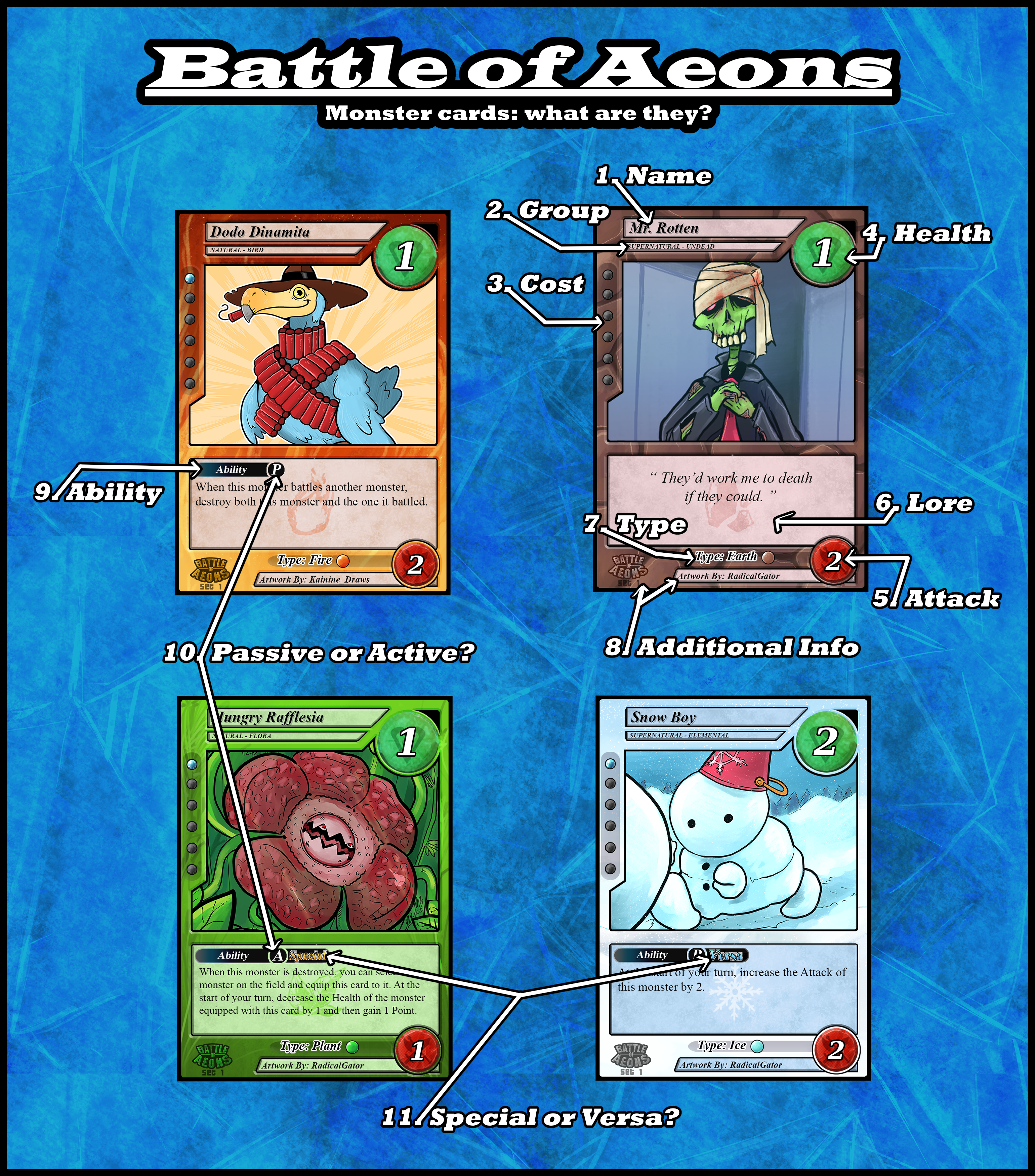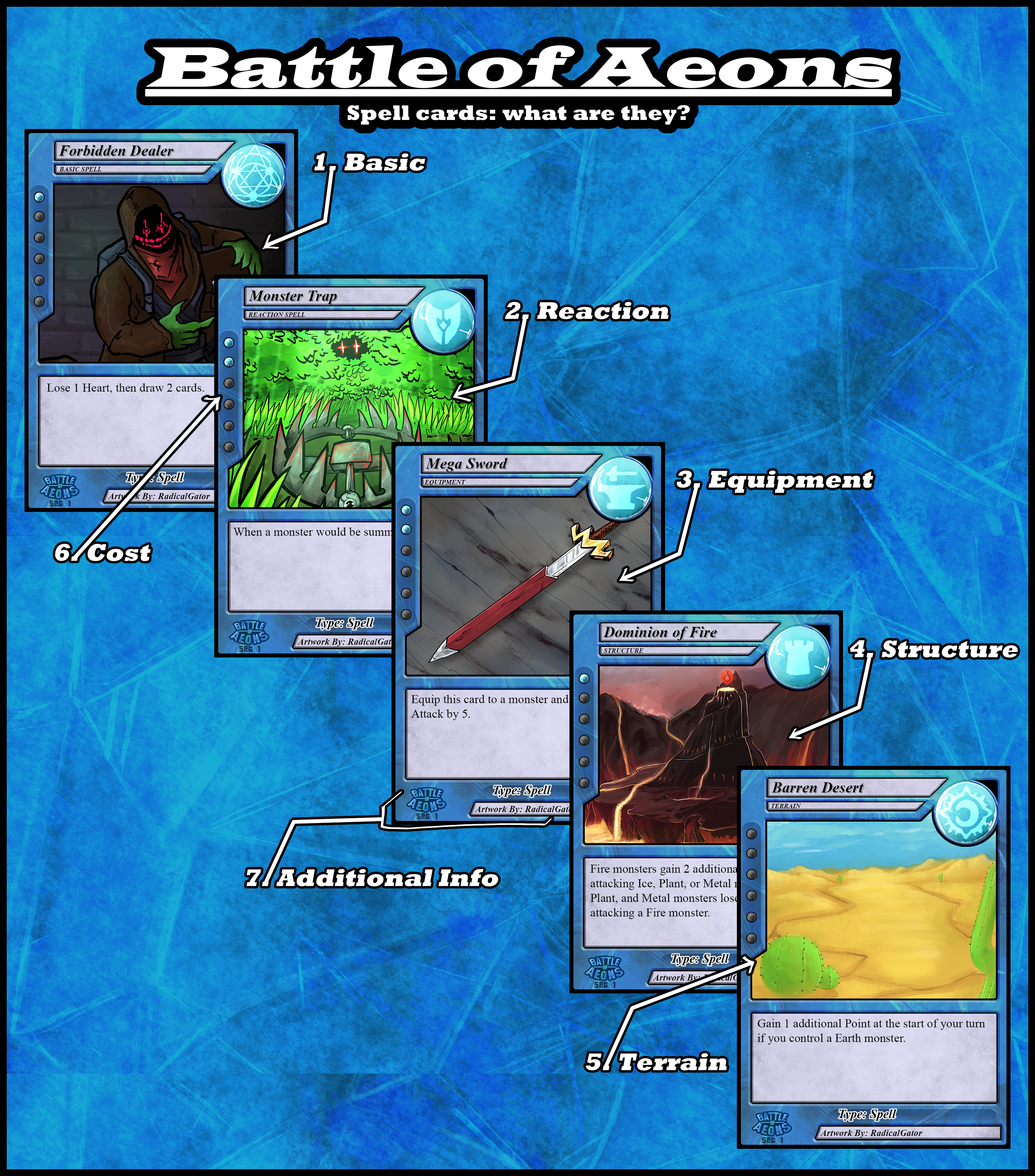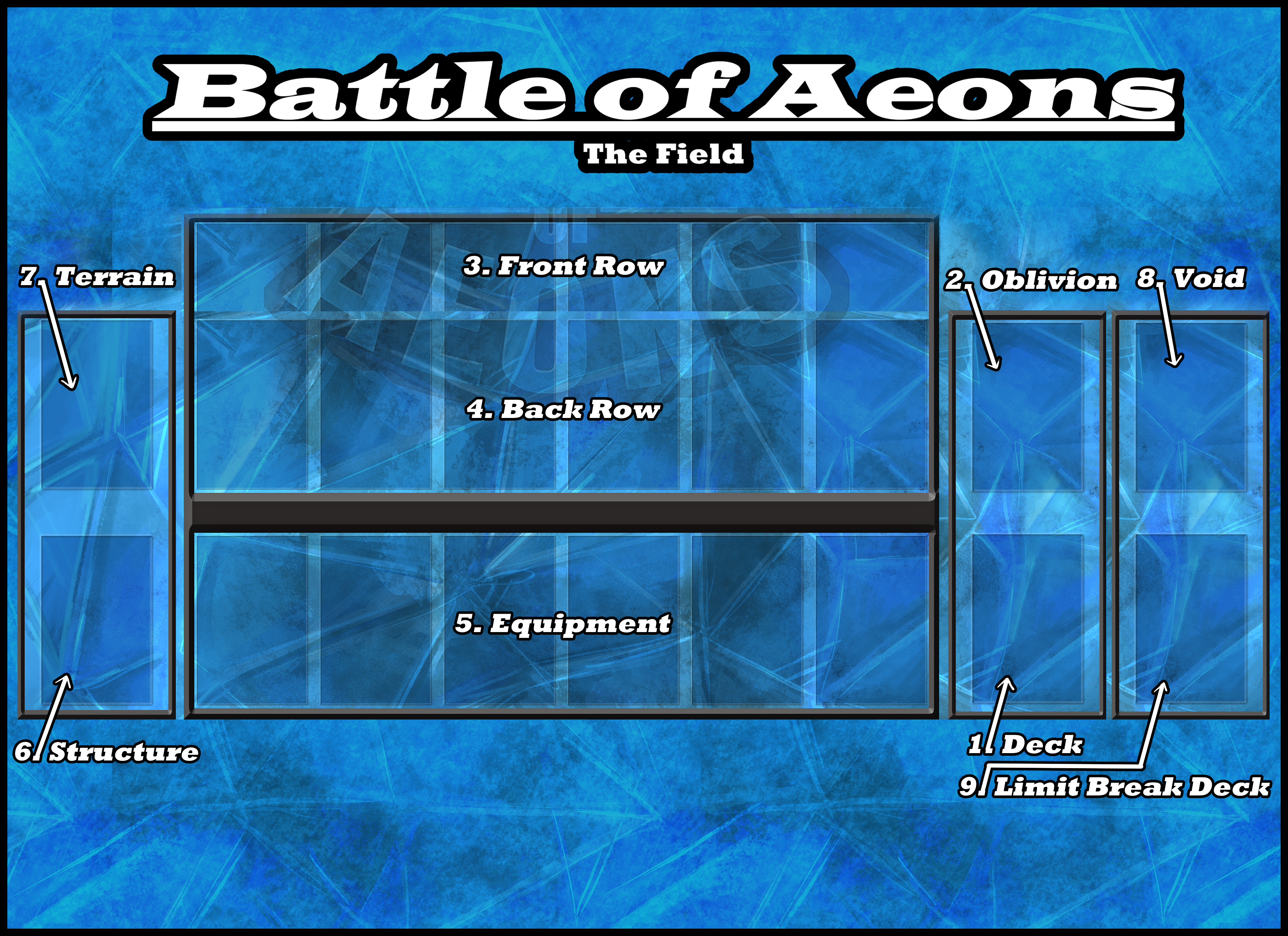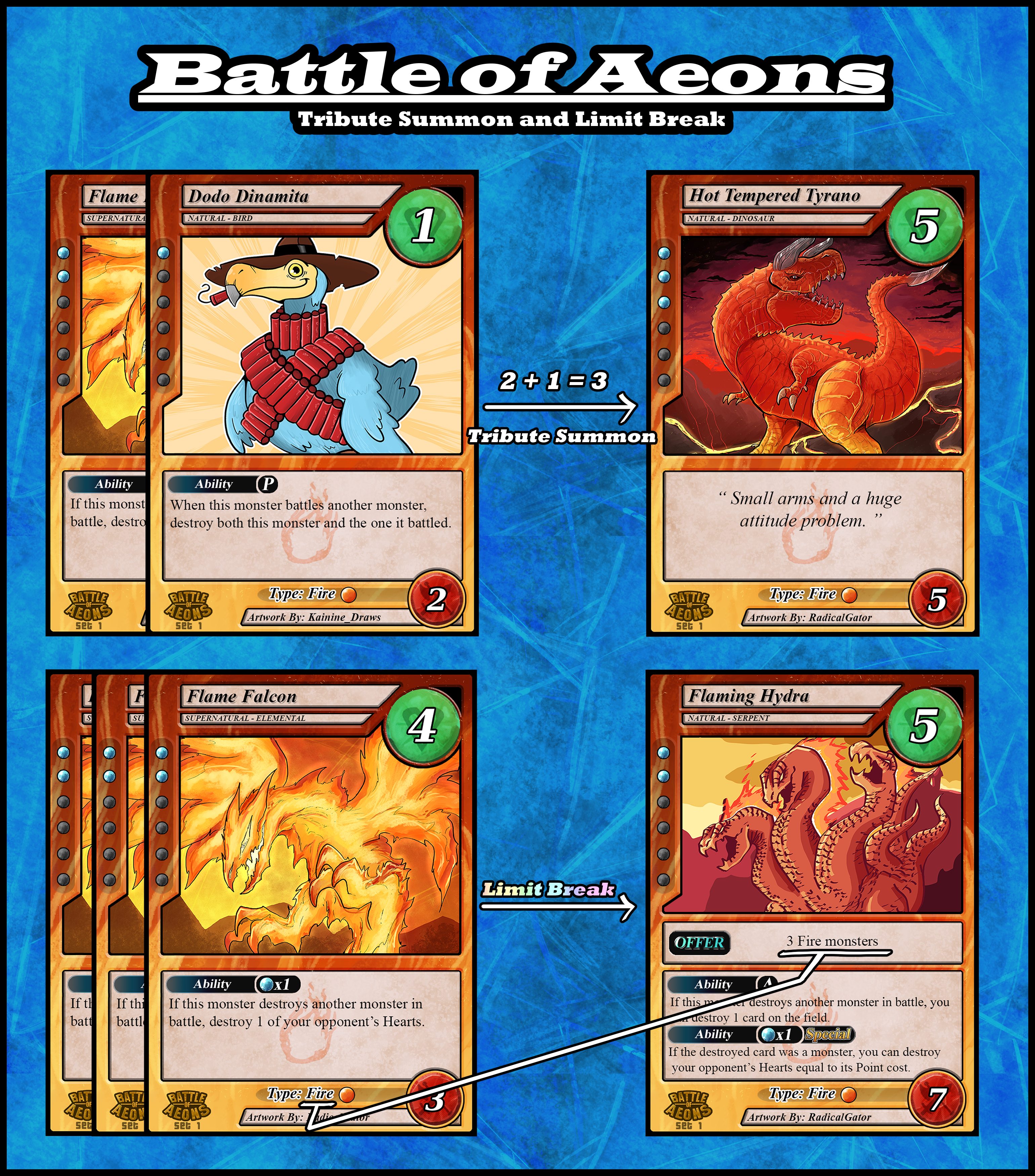Battle of Aeons: Rule book V.1
Battle of Aeons is a trading card game where two (or more*) people can battle each other using decks of 50 to 60 cards they’ve collected to defeat and reduce their opponents total Hearts to 0. There are over a hundred different cards to pick for building your deck, along with many different ways you can use them in developing your own strategies. This rulebook will help you understand how to play Battle of Aeons so that you can get started and eventually master your knowledge of the game's mechanics. If there are any questions you have, you can always drop one in the ‘Chatter of Aeons’ tab or read our FAQ to see if we already have addressed it.
Getting started
When starting a game of BoA (Battle of Aeons) there are several items you will need to be ready to play. Beginning with the obvious, you will need a deck. When building a deck it will have to be 50-60 cards total, with a maximum of 4 copies per card (this limit also applies to the Limitbreak deck). In addition to a main deck, you can have a Limitbreak deck (max 20) and a side deck (max 20). A side deck is best used for matches where you can exchange cards between your main deck and side deck to help adjust your strategy when facing a harder opponent. When building a deck, there are additional items worth having that may assist you with specific mechanics of the game. Dice, coins, and counters all can help keep track of changing stats and turns, along with aving a calculator or pad of paper for Heart and Point totals.

-
1: NAME
The name of the card, this will always appear as “Name” in ability text.
-
2: GROUP
This is the category the monster is grouped into. There are three main classes of monster: Artificial, Natural, and Supernatural. Under these three main groups there are a lot of subgroups such as: Dragon, Undead, Machine, etcetc.
-
3: COST
The Cost/Point Cost is how many points you must spend to summon the monster. The amount of points is equal to the amount of blue dots that are filled in.
-
4: HEALTH
The Health of the monster is its total amount of damage it can take before being destroyed by battle. Damage is carried over between turns, so an attack that won't kill a monster will still lower its health so that the next attack may be able to finish it off.
-
5: ATTACK
The Attack of a monster is the value it will hit another monster with in battle.
-
6: LORE
Present only in monsters with no abilities. This section usually exists to give these "vanilla" monsters more flavor and depth.
-
7: TYPE
Monsters come in many elemental types, there are a total of 11 monster types. Each type has its own unique symbol, border, and colored dot here in the type bar. When building a deck to play with, monster types can help determine what monsters best work together with each other and with certain spells.
-
8: ADDITIONAL INFO
This area holds non gameplay related information. The card's set it was released under and the artist that drew the card's artwork will be located here at the bottom of the card.
-
9: ABILITY
Unlike "vanilla" monsters, some monsters have abilities in their "lore box". Abilities vary and can do a wide range of things, make sure you read a monster's ability before you use them. Generally monsters can only use their abilities in the front row.
-
10: PASSIVE OR ACTIVE?
When reading a monster's ability it is important to check if it is a Passive or Active ability. Passive abilities are denoted by a P located after the ability symbol and are not optional. Passive abilities will always go off when their conditions are met (if there are any) and can activate on either players turn. Active abilities are denoted by an A located after the ability symbol and are optional. They can be activated when their conditions are met, and generally can only be used during your turn.
-
11: SPECIAL OR VERSA?
In addition to if an ability is Active or Passive, some abilities have additional special attributes. When an ability has the Special symbol at the end it can be used during either players turn, this symbol is usually only on active abilities. When an ability has a Versa symbol at the end, that means the monster can use that ability while in the back row.

-
1: BASIC
Basic spells are as their name states basic. They generally can only be used from your hand, during your turn.
-
2: REACTION
Can be used on either player's turn, generally in reaction to spells, abilities, the summon of monsters, etc etc.
-
3: EQUIPMENT
These are spells that equip to a monster, they will stay on the field as long as the monster remains on the field, there can only be a maximum of 6 Spell Cards in the equipment zone at a time.
-
4: STRUCTURE
These spells are placed to the left of your equipment Zone. They remain on the field until they are destroyed or an ability removes them. You can also remove them by activating another Structure Spell as there can only be 1 Structure Spell active at a time for each player.
-
5: TERRAIN
These Spell Cards are like Structure Spells and will remain on the field until removed by similar means. They are activated in the Terrain zone right above the Structure zone.
-
6: COST
Just as monsters cost points to summon, spell cards also require points to activate (sometimes). The amount of filled in blue dots is the amount of Points one must pay to use the card.
-
7: ADDITIONAL INFO
Same as the monster cards, this sections lists off the release set and the artist that created the artwork for the card.

-
1: DECK
This is the zone on the field where your finished deck will be placed. Decks generally are 50-60 cards.
-
2: OBLIVION
When cards are used, destroyed, discarded, etc etc they are sent here. This is the Battle of Aeons discard pile.
-
3: FRONT ROW
When a monster is summoned it can be summoned to the front row or back row. While in the front row monsters can use their abilities, attack each other, and protect you from direct attacks.
-
4: BACK ROW
Monsters can also be summoned to the back row or moved there. While in the back row monsters cannot attack, use their abilities, be attacked, or be selected by other card abilities. Additionally while in the back row monsters are still treated as being on the field though they cannot protect you from a direct attack while in the back row.
-
5: EQUIPMENT
When you equip cards to monsters on the field the equipped card is placed here.
-
6: STRUCTURE
Activated Structure spells are placed here.
-
7: TERRAIN
Activated Terrain spells are placed here.
-
8: VOID
In some situations monsters are removed from the game, or voided. When a monster or even a card is voided it is sent here.
-
9: LIMITBREAK DECK
Limitbreak monsters are placed here. A limitbreak deck is 20 cards and limitbreak monsters can be summoned directly from this deck when their offering condition is met and their point cost is paid.
How to play
BoA can be played as a single round or a 3 set match. A single round of BoA ends when one player wins. This can be done either through knocking your opponent’s Heart total down to 0 or your opponent runs out of cards. In addition to the previously mentioned win conditions, some card abilities can also win the game by themselves. A 3 set match BoA plays a best 2 of 3 format where the player that has won 2 out of 3 rounds is the winner. Side decks only appear in 3 set matches.
Before you play
Before starting a round of BoA there are a few steps to go over. First off, shuffle your deck and then have your opponent split it. After the decks have been cut, take your deck and place it in your Deck Zone. Do the same if you have a Limitbreak deck to put in the Limitbreak Zone. Then after both players have placed their decks on their sides of the field, play rock paper scissors or flip a coin. The winner gets to decide who goes first. The loser of the previous round gets to decide who goes first the next round if this is a 3 round match. Finally, the game begins as both players draw 6 cards and set their total Hearts to 10 and their starting Points to 5 . At the start of the game when you draw your hand, you may shuffle it back into your deck and draw a new hand if you dislike it. However, your opponent gets to draw 1 card from their deck and add it to their starting hand.
Turn structure
BoA is a turn-based game, as with many more technical games each turn has several steps you must go through before your turn is over. Here are each of the steps included in a turn.
Step 1:
Generally at the start of a player’s turn, they will draw 1 card and gain 1 Point. However, for the first turn of the game this step is skipped and players instead begin at Step 2.
Step 2:
The second step in your turn is the pre-battle step. This is the part of your turn where you can activate Spells and summon Monsters (generally). You can activate and summon as many Monsters as you like as long as you have the points to pay for their cost. Monsters can be summoned in the front and back rows, and can be moved once per turn between the two. Monsters abilities cannot be activated during the battle step (except under certain conditions). Monsters also cannot attack the turn they are summoned if you paid points to summon them or used a spell to summon them. Tribute summoned and Limitbreak Monsters however, can attack the turn they are summoned.
Step 3:
Battle step! This is the part of your turn where you attack your opponent. If your opponent has any Monsters in their front row you cannot attack them directly unless said row is empty. Monsters do 1 Heart of damage to your opponent each time they land a direct hit. Monsters in your back row cannot attack, and you cannot move Monsters from the back row during your battle step. Monsters with 0 attack also do not deal damage to your opponent’s Hearts. Besides battle, Reaction Spells (generally) are the only spells that can also activate during this step if they have an ability related to battle or attacking.
Step 4:
This is just the end of the turn, any card abilities that would activate at the end of the turn activate here. After this step, the turn changes over to the next player and the turn begins again from Step 1 for them.

-
Tribute Summoning
When summoning monsters with higher point costs, instead of paying the points directly you can sacrifice, aka "tribute". monsters you control to pay the monster's summoning cost. The monsters tributed must add up to the cost of the monster you are summoning, or exceed it. Monsters with no point cost are also treated as having a value of 1 point when tributed. In addition to saving points on their summon, monsters that tribute summoned can attack the turn they are summoned.
-
LimitBreaking
Limitbreak monsters exist in a separate deck and can be summoned during your turn by sending the monsters required by their offering condition to your oblivion and then paying their summoning cost. Like tribute summoned monsters they can attack the turn they are summoned.